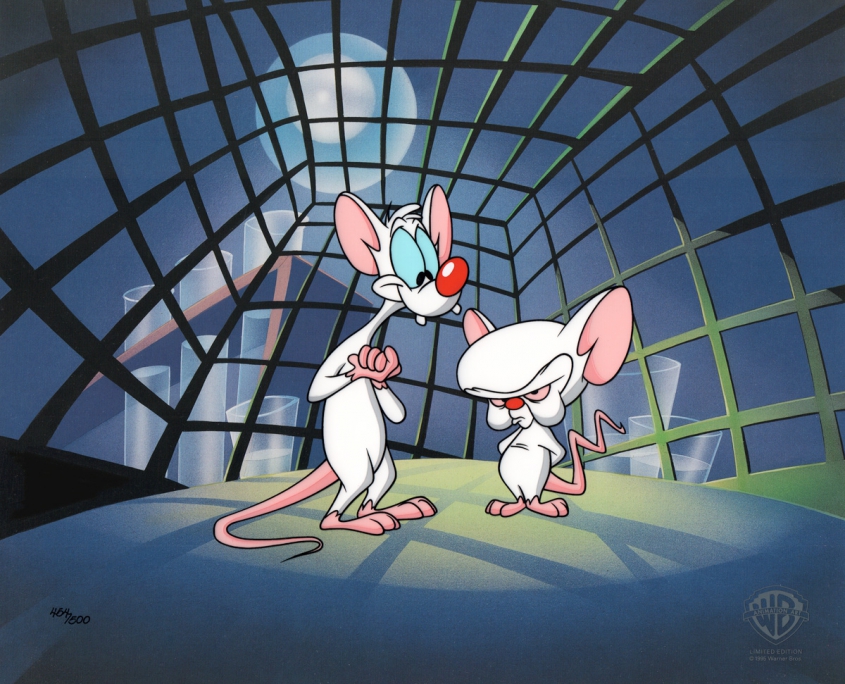You have an idea and want to build a startup but don’t know how to make it take off. I guess this is my best summary without telling you step-by-step. Step by step is a good technique to teach workers to do an excellent and repeatable task. A terrible help for entrepreneurs.

image ref: Warner Brothers
Wanting to take over the world – like Pinky and Brain?
Entrepreneurship is a mindset – making something with nothing. It is all about talent – no skills or education needed, seriously.
1) Don’t overestimate the value of your idea. It is exactly zero. And therefore, no need to fear your idea gets copied. Humans create on average 20,000 ideas in their lifetime. 99.999% get never executed. With over 7 Billion people, that are 14 Trillen ideas to copy. Passion? It is for pussy cats. Value is created by obsessive and relentless execution – nothing else. As such, share it with as many people as you can – every single day. You need that feedback more than anything else right now. And to amplify, use your social network. That doesn’t cost you anything.
2) Develop the best possible solution concept and presentation. Dream it in your head, spin it around. Don’t let it distract you from thinking about what it cost, what resources you would need, how much time you would need, and what problems could occur. Always remember: If you can imagine it in your brain – you can build it with what you have and some other people’s help. So this was not that hard either? Right? You don’t need money for that.
3) Find your co-founders. Let brilliant people complement you. Look for people that hate to do what you love doing and love to do what you hate doing. Put all your savings into this new company and request (insist) your co-founders do the same. Again no hard work at all. You don’t need money from others for that – but risk everything you have. If you don’t – why should others.
4) Together with your co-founder(s), validate your concept with 42 people you think would have a huge benefit from your product or service. If you can’t find them, find out if you are skilled enough to look for them or if the market doesn’t exist. Decide if you want to continue and build it up. It’s that easy. You don’t need money for that.
5) Together with your co-founder(s), build your first prototype and show it to everybody and their dog and get feedback. This is where you use the money you invested. Let people pre-order products (crowdfunding), so you get the liquidity and cash flow to build your first production batch. Start a social media campaign and get more feedback. If this was successful, you know you can create demand, whether there is already a market or not. Now you already have customers and revenue before you even talked to any investor. If not successful, it’s either because you did not learn how to crowdfund (Search on google) or there is no interest in your product.
6) Now is the time you may look for investors and funding to grow. As you have already pre-orders and good feedback, you validated your idea, and funding is not a problem. And that was not hard either. When getting capital use, it EXCLUSIVELY to grow your business, don’t waste it for technology upgrades. Keep running with your weak product (and it is weak) for the next few months and grow revenue. Get at least 1,000 feedbacks from your users and improve rapidly. Offer to upgrade for free.
This is more or less how the top startups in the world did it. And so did I. The most important keys:
A) Entrepreneurial mindset to solve a problem that many other people have.
10 most relevant founders traits
B) Never do it alone – always run with a co-founder that is NOT your best friend.
Best founders are co-founders
C) Forget the money part; if you need money to make money – you are an investor but not an entrepreneur.
You may want to consider joining the World Innovations Forum global exchange for innovative minds. A nonprofit organization from entrepreneurs for entrepreneurs.
Hope that helps.

 The recent cryptocurrency development had put a serious dent in the crypto space. The bubble is clearly burst — very clearly. Speculative investors took quite a hit and the money flow from unknown and possibly dubious sources is drying out. What looks like a disaster to some is a very welcome clearance to others.
The recent cryptocurrency development had put a serious dent in the crypto space. The bubble is clearly burst — very clearly. Speculative investors took quite a hit and the money flow from unknown and possibly dubious sources is drying out. What looks like a disaster to some is a very welcome clearance to others.
 ~3,000 BC. About 5,000 years ago for the first time mankind evolved into a society. Egypt was the birthplace of a society never seen before. Cities were built, trade was created and business developed like never before.
~3,000 BC. About 5,000 years ago for the first time mankind evolved into a society. Egypt was the birthplace of a society never seen before. Cities were built, trade was created and business developed like never before. ~ 1,800 AD. About 200 years ago mankind went through yet another dramatic change bigger and faster than any change before: Industrialization. Technology came into our everyday lives, transportation of goods and people around the world was all of a sudden possible. Financial wealth of an average worker was as great as a kings rich several hundred years ago. We doubled average live expectancy and cut work load in half. We created technology that wasn’t even part of the most remote fictions. In just 200 years we changed the face of earth more than in the 50,000 years before that.
~ 1,800 AD. About 200 years ago mankind went through yet another dramatic change bigger and faster than any change before: Industrialization. Technology came into our everyday lives, transportation of goods and people around the world was all of a sudden possible. Financial wealth of an average worker was as great as a kings rich several hundred years ago. We doubled average live expectancy and cut work load in half. We created technology that wasn’t even part of the most remote fictions. In just 200 years we changed the face of earth more than in the 50,000 years before that. ~ 2010 AD. We already see early signs for yet another dramatic change. This time it is not trade development or technology but a major social shift. In the next 2-5 years our economy will be affected by that change more than through technology in the past. “Democratization of influence” accessibility to nearly “Omnipresent connectedness” and “Direct Access to Experience” (not only expertise) is providing our modern society a tectonic shift that, in my opinion, has an equal magnitude than our technology development a few hundred years ago. Almost everybody can gain “connections” that just a few years ago was a privilege of the top educated people or best connected business executives just 5 years ago. We already experience that business negotiation on all levels change faster than many people realize. Our society is on the verge to yet another major change. This third major step in our new and emerging society is yet another major evolutionary development of mankind – we will recognize the magnitude in maybe only 10 or maybe 20 years from now.
~ 2010 AD. We already see early signs for yet another dramatic change. This time it is not trade development or technology but a major social shift. In the next 2-5 years our economy will be affected by that change more than through technology in the past. “Democratization of influence” accessibility to nearly “Omnipresent connectedness” and “Direct Access to Experience” (not only expertise) is providing our modern society a tectonic shift that, in my opinion, has an equal magnitude than our technology development a few hundred years ago. Almost everybody can gain “connections” that just a few years ago was a privilege of the top educated people or best connected business executives just 5 years ago. We already experience that business negotiation on all levels change faster than many people realize. Our society is on the verge to yet another major change. This third major step in our new and emerging society is yet another major evolutionary development of mankind – we will recognize the magnitude in maybe only 10 or maybe 20 years from now.